August 23rd, 2016 by IISG
“The site doesn’t glow!” assured Michigan Department of Environmental Quality (Michigan DEQ) geologist Sarah Pearson, to the relief of local teachers stepping foot on the land of what used to be the Zephyr oil refining facility in Muskegon, Michigan. The site is now home to a fertilizer company.
The 14 educators were taking part in a week-long West Michigan Great Lakes Stewardship Initiative that brought them to an area of wetlands that endured repeated oil spills during the decades prior to the 1990s that Zephyr was in business—refining, then switching to bulk storage.

Teachers gather to look at a map of the Zephyr site.
Today there’s little visible indication of those frequent spills, which sometimes resulted in fires. Now and then you can still catch a whiff of oil or spot some sheen on the ground, but for the most part the landscape is picturesque.
The grasses are tall and the wildlife has started to return. But contamination, including petroleum products and heavy metals like lead and copper, remain just out of site in the sediment of Muskegon Lake.
“The funny thing is that you knew it existed, back in the day. But when we drove back there, you couldn’t see it. So it’s more out of sight, out of mind,” said Shannon Delora, Muskegon area transition coordinator for students in special education.
“Unless you are taken there, you don’t know all that’s happening, the good and the bad of it all.”
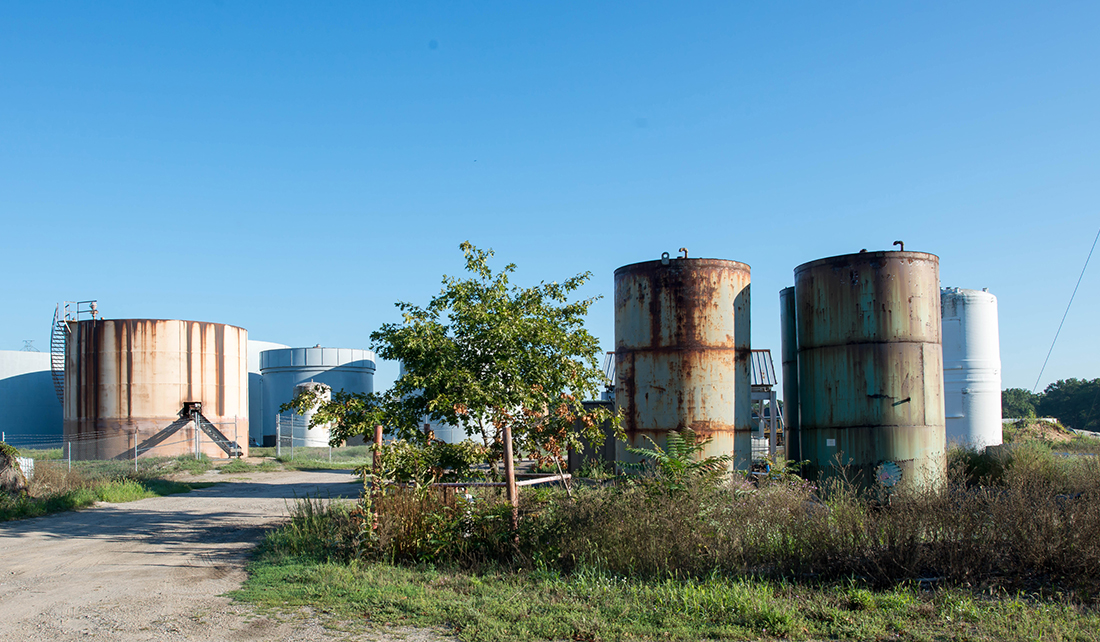
Tanks that at one time stored oil by Zephyr are now used by a fertilizer company that owns the land.
Ben Wegleitner, IISG social science outreach assistant, was on hand to introduce the latest version of Helping Hands, a curriculum that engages upper elementary and high school students in Great Lakes environmental stewardship. It is designed for schools located in Areas of Concern, like Zephyr, but can be applied to any Great Lakes community where large-scale environmental cleanup projects are ongoing.
The lessons touch on a variety of topics, like the effects of pollution and invasive species, and include hands-on activities.
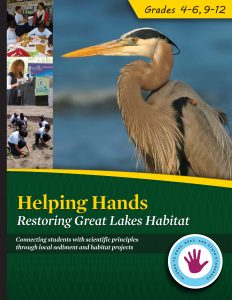 “If you need an opportunity to get your students out in the field and get involved in natural resources and pollution,” Wegleitner told the teachers, “there’s no shortage of opportunities to get your kids interested. Muskegon is a uniquely positioned area for that.”
“If you need an opportunity to get your students out in the field and get involved in natural resources and pollution,” Wegleitner told the teachers, “there’s no shortage of opportunities to get your kids interested. Muskegon is a uniquely positioned area for that.”
The Zephyr cleanup, which is funded through the Great Lakes Legacy Act, involves the U.S. EPA, Michigan DEQ, and IISG. The plan is to remediate 36,000 to 45,000 cubic yards, followed by habitat restoration. It’s slated to get started within the next six months and will take about a year and a half to complete.
“I was very unfamiliar with Zephyr,” said Beth Sipperley, a third grade teacher at Oak Ridge Elementary School.
“To go there and see it and to have the curriculum that really ties into it—one that’s so connected to Muskegon—is great.”
Illinois-Indiana Sea Grant is a part of University of Illinois Extension and Purdue Extension.
June 27th, 2016 by IISG
Last week, I joined U.S. EPA project managers from the Great Lakes National Program Office at the “Zephyr” site in Muskegon, Michigan (named for the Zephyr Oil Refinery that once existed on the property). Zephyr lies within the Muskegon Lake Area of Concern, a designation given because of the environmental degradation in its past. The EPA and the Michigan Department of Environmental Quality (MDEQ) are about to begin a large-scale remediation to clean up the petroleum and lead pollution that remains in the sediment.
On my first day at the site, I was amazed to look south from the bluff to see what looked like a thriving, healthy wetland—albeit, a little overcrowded with cattails. It didn’t seem like the polluted site I’d read about, where petroleum fires were once a common occurrence or where lead concentrations are so high, remediated sediments will not be moved off site until they are treated.
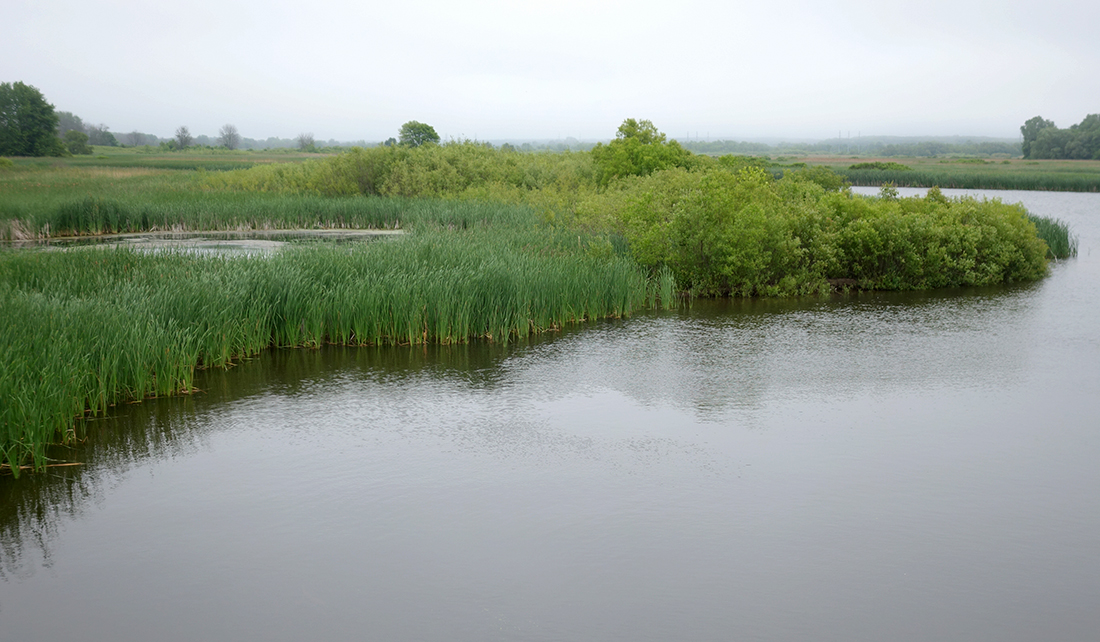
While the south end of the Zephyr site, near the north branch of the Muskegon River looks picturesque, it still contains contaminants and is need of remediation.
But that’s the thing about legacy pollutants: They aren’t always as obvious as a bag of trash or a discarded television. Many contaminants are invisible to the naked eye. Even the visible ones can lie out of sight underwater and still pose a threat to the ecosystem, including the insects, fish, and birds that live there.
The remnants of petroleum are more apparent up close. In some locations at the Zephyr site, the water in the wetlands has an oily sheen to it. At others, there is a faint odor. Despite the issues, I was encouraged by discussions with MDEQ, EPA, and their contractors about the plan of work and project design. The Zephyr site is finally going to get cleaned up!
The work is being funded through a cost-share program between EPA and the State of Michigan under the Great Lakes Legacy Act. Unlike enforcement-style remediation programs, the Great Lakes Legacy Act encourages rapid remediation by offering cost sharing and avoiding blame. A project that could take decades of litigation can instead be completed in 3-5 years through cooperation. And it provides a mechanism to clean up contamination left behind by long-gone, bankrupted industries, as is the case at Zephyr.
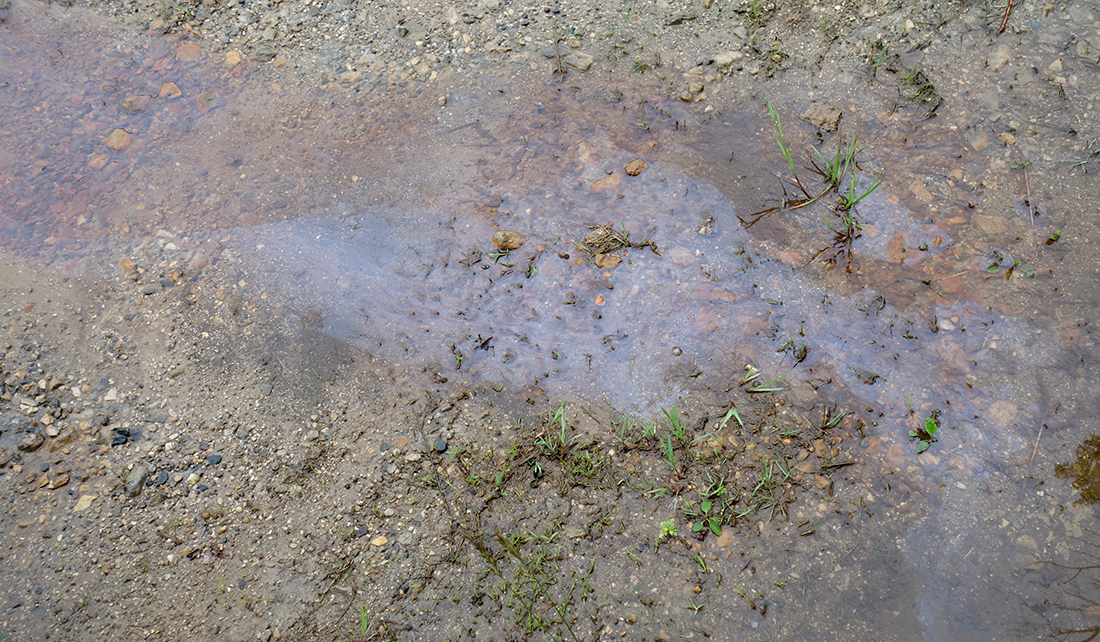
An oily sheen near the Zephyr site.
From what I gleaned from the current property owner (who is not responsible for the pollution left behind by the former landowner) is that nearly everyone in the community is tired of the stigma associated with “the old Zephyr refinery.” And just because the remediation is happening entirely on private land doesn’t mean it won’t benefit the community. Sediment remediation will improve the quality of drinking water and reduce any odor or taste issues. Clean sediment will also provide better habitat for migratory fish and birds; a benefit to tourists and locals, alike.
An added benefit of a Great Lakes Legacy Act remediation project at the Zephyr site is the habitat restoration set to follow. The restoration design calls for open water habitats along with native wetland plants to provide ample habitat for waterfowl and other birds, amphibians, and reptiles while also improving the existing floodplain for the north branch of the Muskegon River.
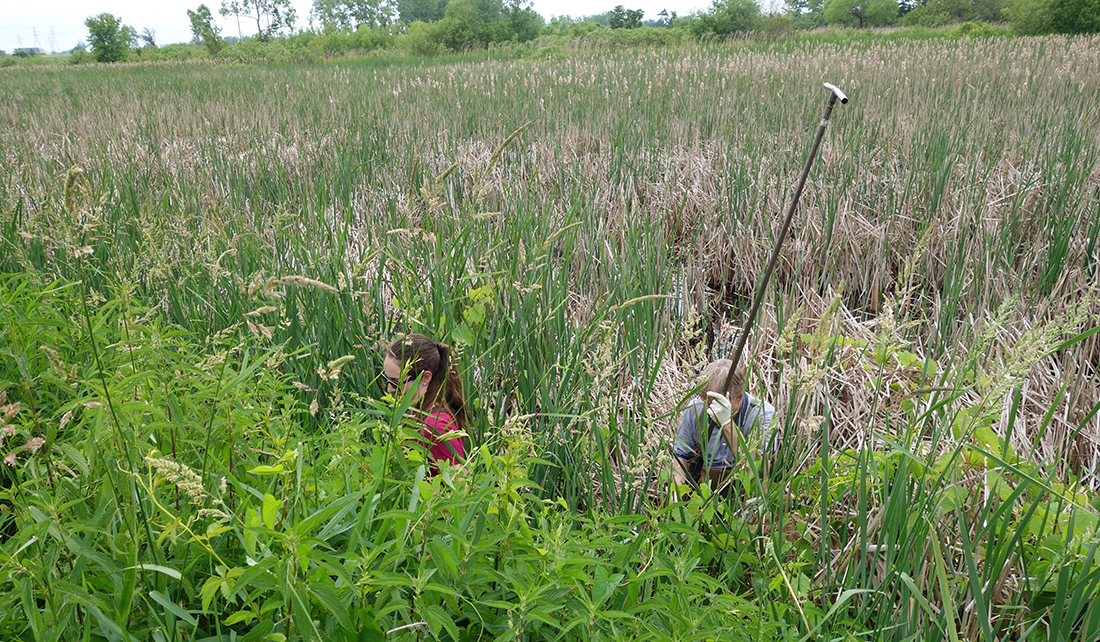
U.S. EPA and Michigan DEQ officials take more sediment samples.
Remediation is tentatively planned for late fall 2016. Once a contractor is on board, equipment will brought to the site for what is called “mobilization.” Shortly afterwards, temporary roads will be constructed, a staging area will be established (to dry out the sediments before being transported off site), and excavation can commence.
My first Great Lakes Legacy Act site visit was very encouraging. Being on site with the project managers, partners, and engineers allowed me to see how a cooperative project functions. I was able to see the sediment up close and understand the concerns this community has had for decades. It’s obvious that a Great Lakes Legacy Act project, or any project of this magnitude, could not be completed alone.
Visit www.greatlakesmud.org for more information and updates on the project.
Ben Wegleitner is the new IISG social science outreach assistant supporting IISG Environmental Social Scientist Caitie Nigrelli.
Illinois-Indiana Sea Grant is a part of University of Illinois Extension and Purdue Extension.
June 15th, 2015 by iisg_superadmin
By Carly Norris
I am excited to be joining the IISG team as a social science research intern with Caitie Nigrelli. This May I graduated with a degree in Natural Resources and Environmental Science from the University of Illinois. I enjoy working with people and helping others to understand the importance of sustained environmental quality. During my time as an undergrad, I worked in two social science labs where I realized my passion for environmental social science research. I became interested in the IISG internship because it would combine this with my love of aquatic ecosystems. Through my internship with IISG I hope to improve my research and communication skills, as well gain experience working with communities.
Saturday, May 30 was my first opportunity to get out in the field and get my hands dirty, literally! Caitie and I traveled north to Milwaukee, joining forces with volunteers from Friends of Lincoln Park and The Park People on a morning Weed Out. Dedicated community members and a plant expert from Milwaukee County Parks worked through the rain to remove garlic mustard and other invasive species from wooded areas within Lincoln Park. A native to Europe, garlic mustard was brought to the states as a salad green and for its proclaimed medicinal properties. It now dominates the understory of Midwestern forests as an invasive, excluding almost all other herbaceous plants and destroying vital mycorrhizal fungi from the soil.
After just three hours of work, volunteers filled 30 garbage bags to the brim. Everyone was enthusiastic to be contributing to Lincoln Park’s restoration efforts. Sally Callan a Friends of Lincoln Park member agreed, “After drying out [from the rain], it was great to feel sore for a good cause.”
The Weed Out was followed by a cook out provided by Environmental Quality Management, the primary construction contractor on this Great Lakes Legacy Act site, where volunteers had an opportunity to gather and meet members of the cleanup crew. Everyone, besides the lone vegetarian (me), enjoyed Milwaukee style brats, (I savored the coleslaw) while kicking back with neighbors and new friends alike after a morning well spent.
Lincoln Park is part of the larger Milwaukee Estuary, a federally designated Area of Concern. Saturday’s restoration event contributes to the work being done in Lincoln Park under the Great Lakes Legacy Act to remove contaminated river sediment, which remains after decades of industrial pollution. The current cleanup targets the river in the eastern half of the park and is the last phase of the Lincoln Park sediment remediation. Creation of The Friends of Lincoln group is a promising sign of the neighborhood’s reinvestment in this beautiful piece of nature.
It was truly energizing for me to see such a diverse group of community partners coming together to improve this local public space as a direct result of the river cleanup. I really enjoyed my time working with this welcoming group of people and getting to know some of what the Milwaukee River has to offer. My roommates and I will also be eating a little healthier this summer with the tomato plants and the garlic mustard pesto recipe I got to take home!
Top photo: A Friends of Lincoln Park member points me to some additional areas for cleanup.
Middle photos: The before and after–Caitie worked to pull this garlic mustard. Native plants now have room to breathe!
Bottom photo: Some workday participants enjoy good food and conversation courtesy of Environmental Quality Management, the primary construction contractor.


 “If you need an opportunity to get your students out in the field and get involved in natural resources and pollution,” Wegleitner told the teachers, “there’s no shortage of opportunities to get your kids interested. Muskegon is a uniquely positioned area for that.”
“If you need an opportunity to get your students out in the field and get involved in natural resources and pollution,” Wegleitner told the teachers, “there’s no shortage of opportunities to get your kids interested. Muskegon is a uniquely positioned area for that.”



